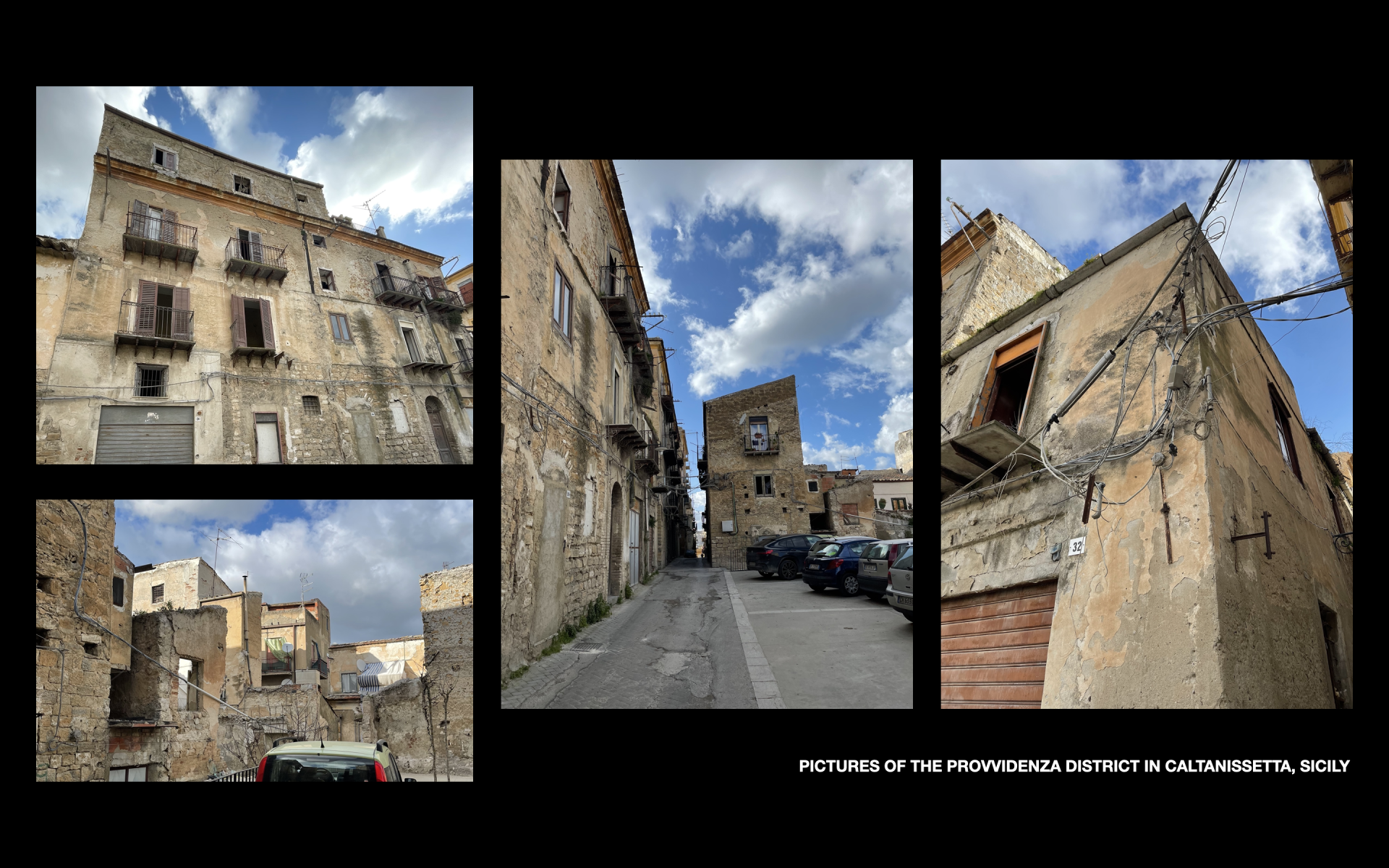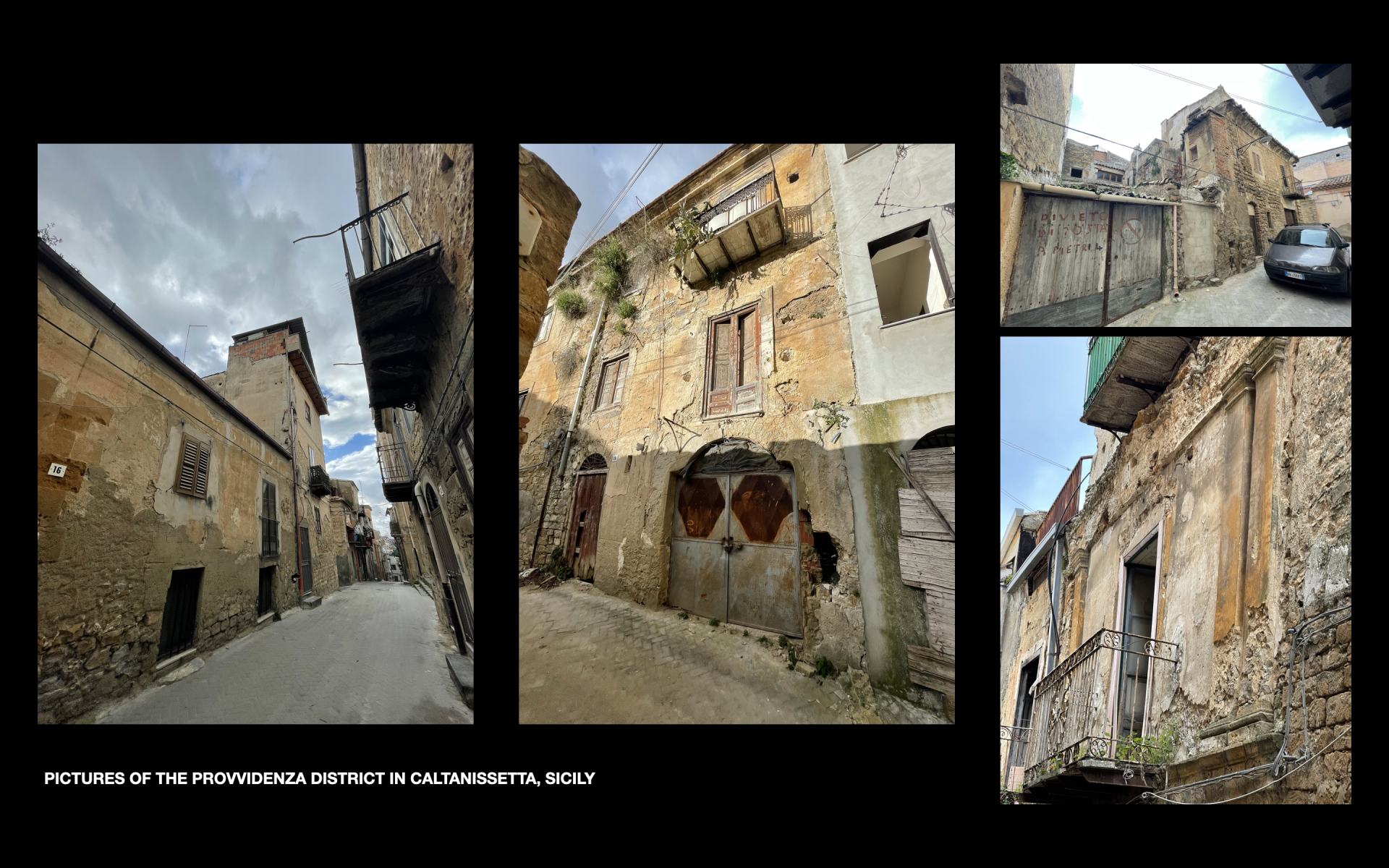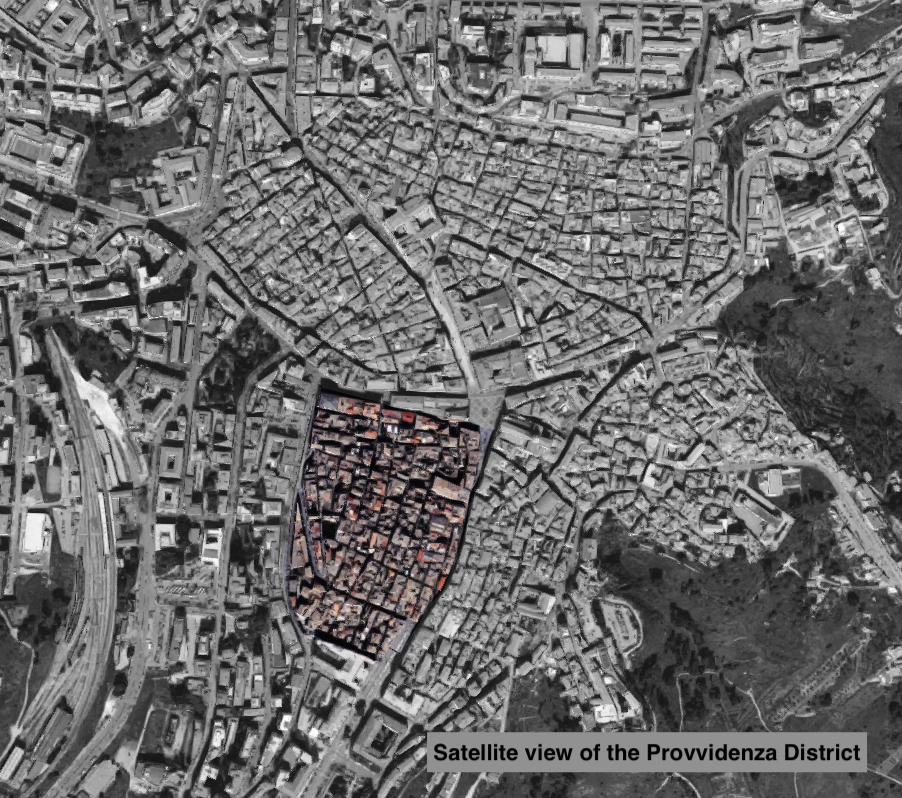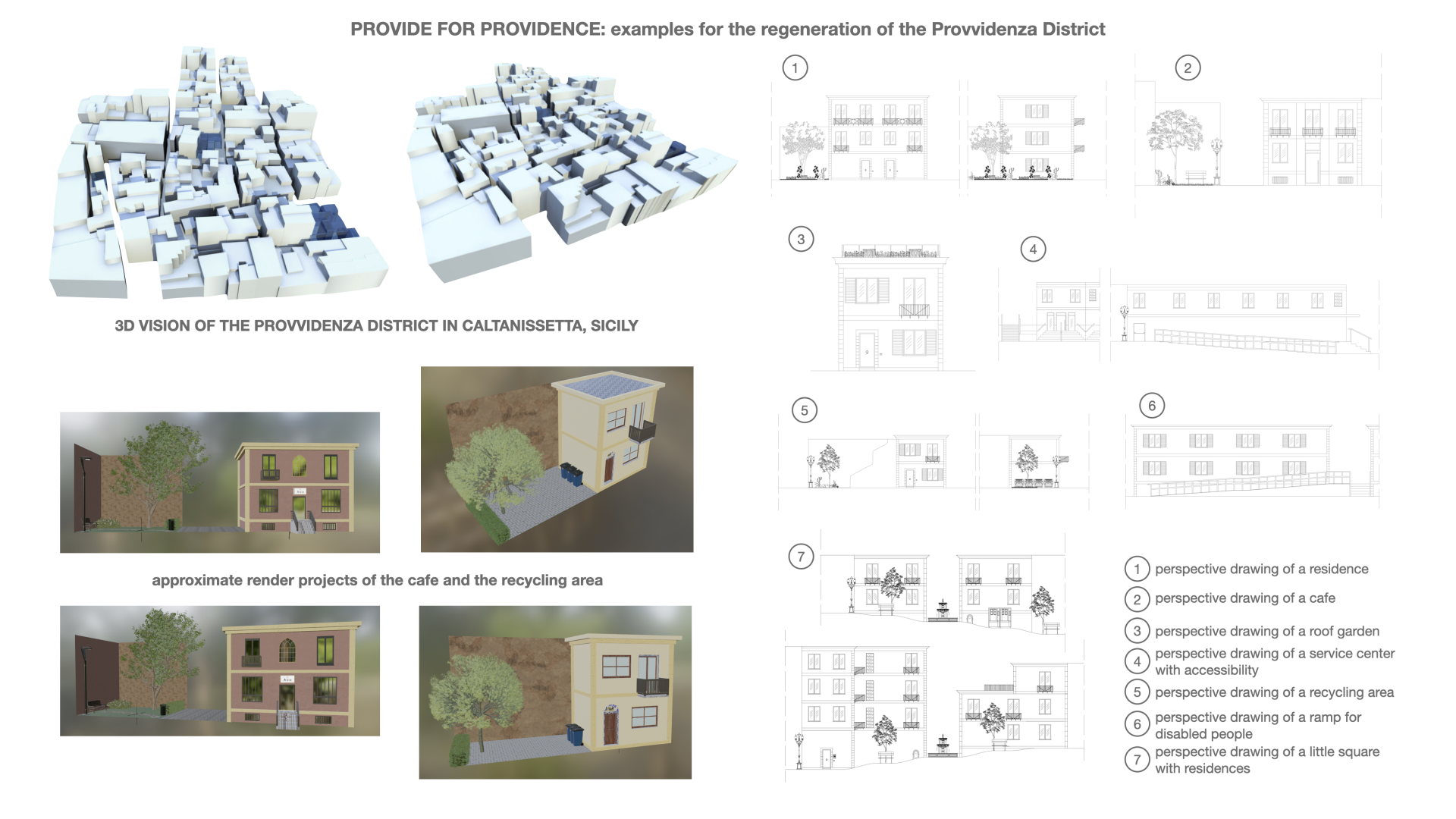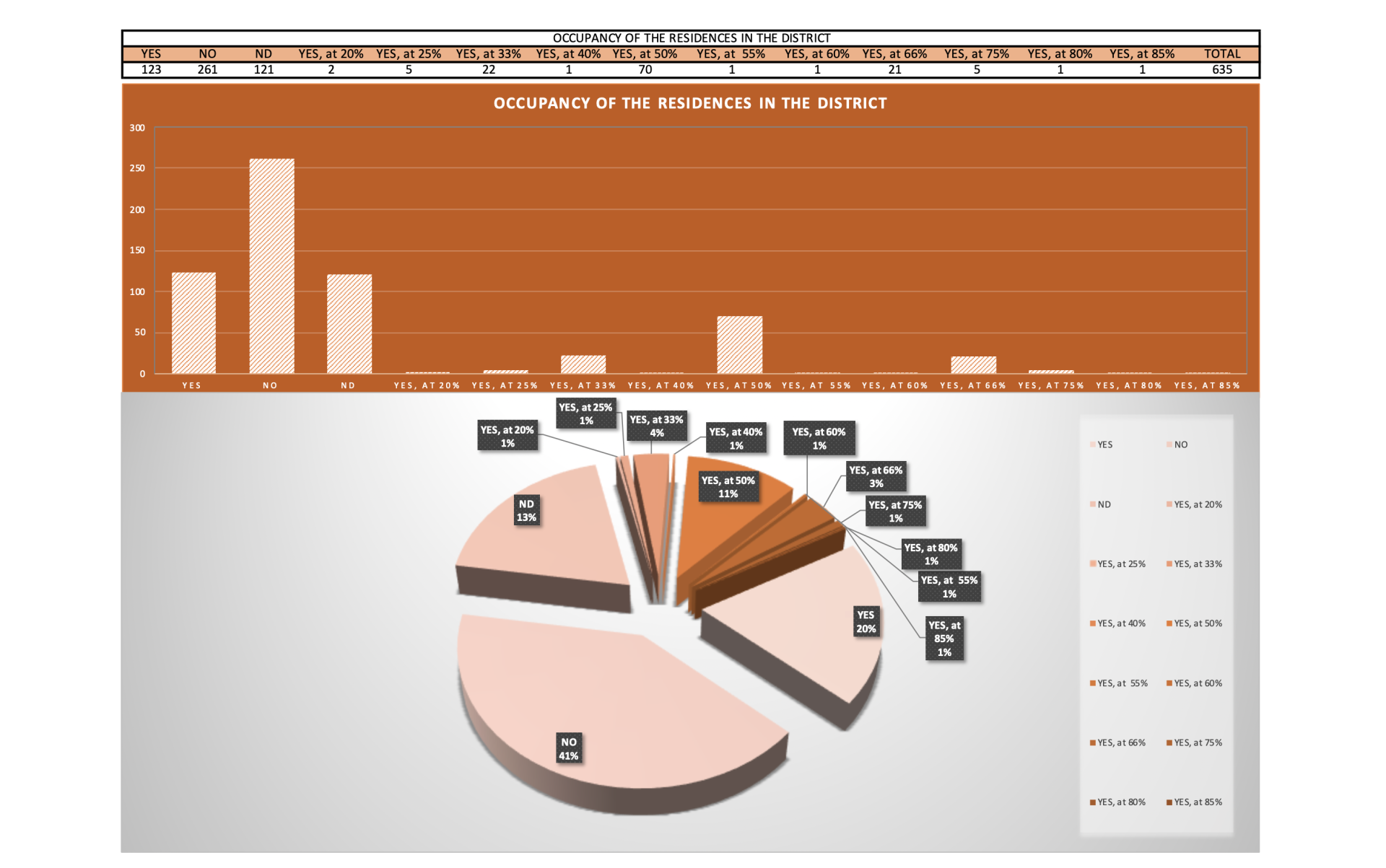Provide for Providence
Basic information
Project Title
Full project title
Category
Project Description
The Provvidenza district in Caltanissetta has been the victim of a social, cultural and environmental paradox for decades: to be considered the outskirt of the city while being in its historical center, adjacent to the central square. The small and beautiful community that survived the depopulation of the neighborhood is strong, multi-ethnic and ready to face change: Provide for Providence is an idea for the future, a real resource and a model for progress of the European cultural identity.
Geographical Scope
Project Region
Urban or rural issues
Physical or other transformations
EU Programme or fund
Which funds
Description of the project
Summary
The idea is to quickly repopulate the neighborhood by eliminating degradation and various unsuitable housing situations that since the last century have caused the downsizing of Caltanissetta into a city of 60,000 inhabitants compared to the 200,000 maximum potential. The General Urban Planning Plan (PUG) and the introduction of the Green Certificate have not solved the enormous waste and miss-use of soil in the district, within which about 50% of the buildings now are condemned or at risk of collapse.
Provide for Providence is an idea conceived by a team of young people of different ages, backgrounds and skills that despite their individual specificity have come together as a group. We are interested in evaluating what we can do to create a sustainable, inclusive and environmentally enriched future. The intention is to make the historic district of Providence a good example of a resilient community through an experimental urban regeneration project based on conservation and a self-sustaining model. The influence of a self-sustaining residence will trigger an overall community response leading to the recovery and repopulation of the district, underlining the project as a model of economic, social and environmental sustainability.
Thanks to the implemented long-term building solutions, the regenerated structures of Providence enjoy the golden days of sunlight, on an ancient hill. Securing the buildings will allow operators to intervene on the water network, that today loses about 80% of the total amount of potable water in the delivery system, ensuring to the whole district access to drinking water directly from the city aqueduct. Eliminating leaks and restoring water pressure gradually solves the problem of cisterns on roofs, often made of asbestos-cement or dubious materials.
Key objectives for sustainability
The lack of a viable waste cycle, the decay of buildings, and the inadequacy of environmentally friendly culture take all parts in the district’s degradation.
Based on what emerged during the analysis phase, the team developed a waste-management plan involving the implementation of recycling areas and incentive plans to lead the community towards a proper waste disposal.
In order to regenerate and enhance the efficiency of the pre-existing buildings the renovation works will be realized with the use of technologies aimed to create a self-sufficient, eco-friendly, green energy community.
The introduction of photovoltaic panels and solar thermal systems permits an energy sharing concept, making Providence a functional self-sustained district, giving a taste of future and cultural progress.
The creation of walkable flat rooftops and roof gardens allow an ideal thermal insulation of buildings and an energy dispersion’s reduction up to 30%.
The goal will be to achieve a circular and sustainable supply-chain, in order to do so it is necessary to maximize the reuse of waste materials through recycle and up-cycle operations. Technologies such as Re-Con Zero Evo® allow the reuse of returned concrete directly on the construction site, in order to reduce costs and the use of raw materials.
The use of Material Passport will also allow in the future to recognize, maintain and safely dispose or recycle any type of product used during the interventions of conservative regeneration and requalification.
Provide for Providence creates accessible pedestrian paths, integrates an extensive study of urban arboriculture respecting the native flora, installs City Trees in the green areas crated to make the Providence district an exemplary experiment of resilience, strenght of its architectural features and central location in Caltanissetta.
Key objectives for aesthetics and quality
The project has identified strategic points to start with an urban updating in the name of the New European Bauhaus values, starting from construction projects that eliminate the risk of collapse and doesn't go against the architectural codes of the buildings in the same area.
The district’s renewed aesthetic is realized with local manpower, materials, techniques and design (and provides for the realization) It involves the creation of new spaces designed to preserve the area and make it an engine for a new cultural feeling.
After the following interventions aim to achieve a conservative regeneration of the Provvidenza district:
- Restoring the original dimensions of buildings by reinstating their original height, allowing natural light to shine through the streets.
- Conservative restorations and extraordinary maintenance aim to restore, insert and enhance the layout of the buildings in order to give the neighborhood a well-kept appearance, combining tradition with innovation.
- To convert unstable and inaccessible buildings into green and recycling areas decorated by local artists.
- Implementing urban design with murals, sculptures, practical elements such as solar lights with integrated solar panels, lights night the use of Structural Imaging Technology on the new cement plasters: all this to blend mixed techniques of contemporary knowledge with the local know-how traditions and craftmanship.
- Removal of architectural barriers by replacing the existing concrete pavement with a new and durable one inspired by the original to make it more accesible.
A strong will for conservation and a skillful use of recovery technologies are combined here to simultaneously save the environment and area history
“There is only one art, but a thousand forms”: the architect returns to be director of this orchestra.
Key objectives for inclusion
Defining the project on the basis of sustainable investment dictated by EU taxonomy, in accordance with recent ESG reports and the NGD, main importance was given to underline and put in the foreground the respect for people and cultures.
Interviewing the neighborhood community highlighted the absence of social inclusion and educational initiatives, despite being present in Caltanissetta an heterogeneous foreign community of third generation.
The transformation of the old neighborhood theater into a NEB space accessible to all directly promotes community integration and drives existing projects of local associations. This will allow citizens to become themselves spokespeople of a new participatory mode in which the person is at the center of the neighborhood, aware of being a resource and a need for the town itself.
Within the district everyone has a role aimed at shepherdin each other to a correct and gradual change of mentality.
Initiatives such as language and training courses, digital and creative workshops, ateliers, role-playing games, Gulliver maps and shared simulations allow each member of the community to express their talents, ideas, criticism and observations, creating a fast and dynamic network even on social media.
Now finally being able to clearly inform themselves and others about the latest news of the district and the city itself, having the certainty of being listened to and protected, the sense of community is reinforced, strengthening growth and reducing inequalities.
Outside the NEB space, the new square and the multi-ethnic-inspired premises encourage the meeting and a new flow of social life, blending different ages and cultures.
The pedestrianization of the neighborhood seems obvious and necessary in order to preserve the values and social harmony that this Idea wants to achieve, thorough the removal of architectural barriers, the installation of ramps and the creation of tactile and olfactory paths.
Physical or other transformations
Innovative character
A first aspect that joins together the three above dimensions is to sensitize the community into remediation actions towards neglected land, involving these new spaces more and differently through the project.
The buildings, returned to their original shape and load, combine the use of bio-paints and advanced concretes (PMMA) to local materials such as limestone and Sabucina stone, or to local craftsmanship of gypsum manufacturing. All this in order to create a network of exchanges that interconnects the construction's supply chains and the in charge institutions responsible of waste management in Caltanissetta's area.
The restoration of buildings with hanging gardens and photovoltaic panels, the renovation of ruins into green areas, the laying of paths and ramps, are all elements designed to promote the accessibility of the neighborhood. Like this the community finds a greater employment in the range of services offered, such as activities of public participation, cultural events and also the fundamental maintenance planning of neighborhood itself.
Access to the aqueduct's water and the creation of an energy community, stabilize and create new lasting social relationships, leading to a path of mutual respect.
The local associations and workers who have long promoted greater awareness of the neighborhood will expose and develop their projects at the NEB space, exchanging and debating new ideas.
Generating movement and dynamism within the Providence district increases its relevance, its attractiveness for real estate companies and service managers.
The colors, decorations and messages of the local street art are accompanied by green areas, raising awareness in respect for tradition and good living.

